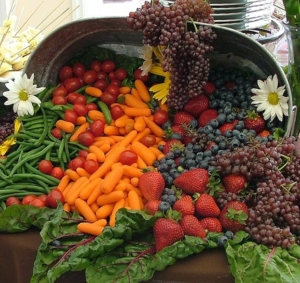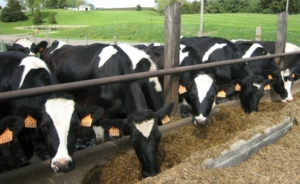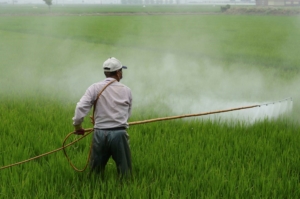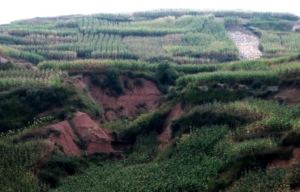Food: Abundant for How Long?
by Gary Gardner
Global food production today is cornucopian: More food, of greater diversity, is available to more people in more places than at any time in human history. At the same time, this food abundance has a dark underbelly. Some 828 million people—nearly ten percent of the human family—are chronically hungry, and two billion people lack critical micronutrients such as Vitamin A and iron. This juxtaposition of increasing abundance and chronic scarcity might suggest that ending hunger simply requires extending 20th century agricultural success to the entire human family. Is doubling down on such success the recipe for eliminating hunger across the Earth?

Food is abundant. For many. For now. (Jina Lee, CC BY-SA 3.0)
No, it’s not, because modern agricultural bounty has an Achilles’ heel—resource overshoot—that is poised to limit agricultural output. Expansion of irrigation and quality land are constrained by overuse of water and farmland. Add climate instability and the challenge to food abundance at the global level becomes clear. This, at a time when increased populations, richer diets, and expanded use of crops for fuel are driving up demand for agricultural products. The double challenge to the world’s farmers from growing demand and constrained supply poses an ever-rising obstacle to a sustainable agricultural system that can meet the needs of all the world’s people.
Global population increased more than 5-fold between 1900 and 2022 and is projected to expand by another 21 percent by 2050. But growth in raw population numbers is only part of the increase in agricultural demand. Dietary improvements and the pressure for biofuel production are also in play.
Diets become more resource-intensive with prosperity. A poor person whose income rises typically supplements their customary plate of plant-based foods with animal protein in the form of milk, cheese, meat, and eggs. The result is a more interesting diet, but also an increase in the person’s grain consumption if the meat and other livestock products come from grain-fed cows, pigs, and chickens. So a person consuming grain-fed livestock products ramps up pressure on the global food system to produce grains. This is happening today, millions of times over, as people of lower incomes worldwide get a taste of prosperity and join wealthy consumers with long-established meat-eating habits.

Pasture-fed no more. (Sharee Jablonski, CCO-1.0)
At the same time, production of biofuels (ethanol, biodiesel, and other fuels made from grains, sugar, and oilseeds) eat up large shares of grain and oilseed output in some countries. More than a third of the US corn harvest is used to make ethanol, while large shares of Brazil’s sugar crop and of oilseed production in the EU are used for biofuels. Demand for biofuels has contributed to rising food prices in the last decade and could increase with the interest in “sustainable aviation fuels,” some of which are crop-based. The United Nations Food and Agriculture Organization (FAO) has called biofuels a “new market fundamental” that affects prices for all cereals and arguably could threaten food abundance.
The bottom line is that population growth, richer diets, and fuel crops are projected to boost global demand for food by 35–56% between 2010 and 2050, according to a 2021 analysis of 57 studies.
The Solution to Date: Intensification
While food demand grew robustly in the past half century, the extent of land under cultivation grew much more slowly. Rather than plant more land, farmers could intensify production using mechanization, synthetic fertilizers, new seed varieties, irrigation, and other stimulants to coax more output from each hectare of land. Meanwhile, as many oceanic fisheries collapsed, fishers also turned to intensification. The output of aquaculture, or fish farming, more than tripled between 1997 and 2017, and became a key near-term solution for meeting market demand for fish.

More inputs, more output? (Rawpixel, CCO 1.0)
But the intensification strategy appears to be losing steam. The growth rate of global agricultural output for the 2010s was the lowest in six decades, a third lower than the rate of the 2000s, because of a slowdown in the productivity of inputs like irrigation, machinery, and fertilizer. The USDA reports that the contribution of such inputs to farm output has actually turned negative in some countries in Africa and South America in the past 30 years as climate change bites and as farmers expand onto marginal lands. This could happen, for example, if irrigated land becomes salinized; successive applications of water could lead to lowered output.
In other words, the modern strategy for increasing output—intensification of agriculture—has slowed, while farmers seem to be turning again to the ancient strategy of expanding crop area. But an extensification strategy for food production has real limits. Already, half of the world’s habitable land is used for agriculture, greatly reducing the area available to nature.
Constrained Supply?
Indeed, land suitable for farming, but not yet under cultivation, is not widely available in most of the world outside of South America and Africa. The FAO reports that no new prime or good land remains in populous countries in the Near East and North Africa, South Asia, and in Central America and the Caribbean.
In addition, remaining land may be of low quality. A 2008 study assessing degradation at the global level suggested that some 24 percent of the world’s land is degraded. The 2018 World Atlas of Desertification found that more than 75% of the Earth’s land area is already degraded, and that over 90% could become degraded by 2050. Part of this degradation is erosion, the steady loss of soil to wind and water, which has advanced by 2.5 percent between 2001 and 2012, due largely to deforestation and cropland expansion.

Damaged land reduces supply (Desmanthus4food, CC BY-SA 3.0 US)
Climate change will on balance be a drag on farm output, although some regions will benefit from warmer temperatures and new patterns of rainfall. At the global level, the IPCC has reported that net agricultural production could decline by 0.2-2.0 percent per decade over the remainder of the century, even as demand increases by 14 percent per decade. Higher temperatures are projected to lower some crop yields and to increase the prevalence of weeds and pests. New rainfall patterns overall increase the risk of crop failures, and over the long run, of production declines. The new patterns are expected to have much greater negative impacts in low-latitude (often developing) countries than in high-latitude (often wealthy) ones, and these divergent results are projected to widen over time.
Add to these losses the climate- and growth-driven loss of 40-60 million hectares of irrigated area in the western USA, China, and West, South, and Central Asia, and the pressure to produce on remaining agriculture land increases further. While climate change will also increase irrigated potential in some regions, including the northern and eastern USA, parts of South America, much of Europe, and Southeast Asia, large investments in irrigation would be required to realize production gains there, threatening food abundance.
Food Shortfalls are Unnecessary
In sum, the food abundance that characterized the late 20th century through today was built in response to a rapid increase in demand for food and later, for biofuels. Now, that growth-driven bounty is itself threatened by yet more growth, as resources are overtapped to step up production. The threat is not immediately apparent, as many agricultural products are produced in surplus at the global level. But at the national level, food security is increasingly a serious concern.
A 2023 study found that only one-third of the global population lives in countries that are nutritionally self-sufficient. By 2050, billions of people worldwide will live in countries that are not self-sufficient in food. The shortfall in domestic production is especially acute in nations in the Middle East, North Africa, and the Andean region, where several water-scarce nations rely on food imports as a water-saving strategy. But whether all food needs can be met through trade is an open question.
Steady state and degrowth economies would go a long way toward managing resource stress in the agricultural sector. A stable population removes a key source of pressure on food supplies, while a shrinking population could create room for richer diets for low-income people without demanding more of Earth’s land and water endowment. (This room is also created with every commitment by wealthy consumers to eat lower on the food chain, a step consumers can take immediately, independent of whether steady state economies are created). Similarly, ending growth in air travel could remove pressure to create biofuels for aviation, opening up more land and water for food production.
The future of food abundance in an ever-growing economy is bleak. But bounty for all is a realistic goal in steady state economies that seek to operate within boundaries set by nature. Ours is a cornucopian planet that offers great abundance—as long as we treat it with care and respect its life-giving dynamics.
Gary Gardner is CASSE’s Managing Editor.







How absurd! Precious land being used to fly airplanes. In reference to one theme in Gary’s article: intensification, I have a question. What if vast areas of suburbia that replaced farmland were re-imagined to produce food? What if millions of water guzzling front- and back-yard lawns were used instead for intensive gardening? These organic gardens could be worked by the home-dwellers themselves, or non-profit organizations could come to your house and make an agreement to “farm” your yard and you would receive some of the food in return. I’ve heard of such systems work on a small scale in places like Detroit and Orlando, as well as in some Canadian cities. In this way, food production would be localized, lowering the average number of miles it takes for a tomato to travel from farm to supermarket to kitchen.
Mark, you took almost all the words out of my head and from my mouth. Let’s get local, not-for-profit food provisioning and all kinds of community sponsored and worked gardens. Food is not a commodity; that’s why tons and tons are wasted. The problem is that money is political and until we learn how to be political without it, at the local level with everyone’s needs considered and as much commitment as possible, we’re not going to have much success getting to a SS economy let alone a truly ecological sustainable and just one. Thanks for your thoughtful words.
Thanks, Mark and Nick. Yes, converting lawns to productive plots is a great idea. It would clearly save water (lawns are very thirsty) and would take some pressure off of farmland as well. There was a “yardfarmer” movement in the US a few years back, but I’m not sure how active it is now. Here is a fun trailer of a video series on the movement:https://www.youtube.com/watch?v=Xu-TPnUWdac. Happy planting!
Thank you for this. However, one step towards a solution is barely touched upon: A plant-based diet for all. Joseph Poore, an Oxford University Researcher, has done some data analysis demonstrating what impact a conversion to a vegan diet would have on GHG emissions. In terms of individual actions, its impact far outstrips anything else a well-meaning citizen can do. For more, see here: https://erwindreessen.substack.com/p/going-vegan
As if there’s not enough to worry about, I’ve heard over the years some concerns about ‘Peak phosphorus’ occurring in 10 or 20 years, as phosphorus is critical to growing food. It’s hard to tell just how serious this might be. My sense from what I’ve read is that it will be manageable, because phosphorus can be captured and recycled, but the effort to do so will make agriculture more complicated (and expensive) than what we’re used to.
You’re right, Cole. Phosphorus is in relatively short supply, and available from only a few countries. Recycling is possible, but I don’t know that it’s being pursued in a systematic way on a large scale. Thanks for weighing in!